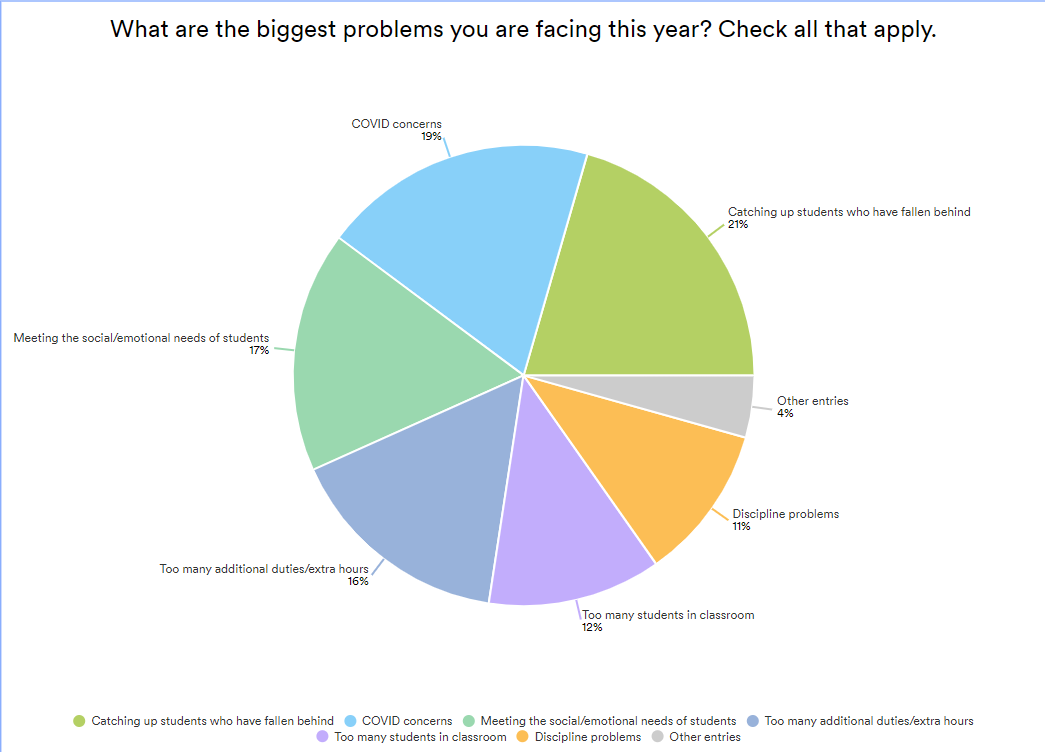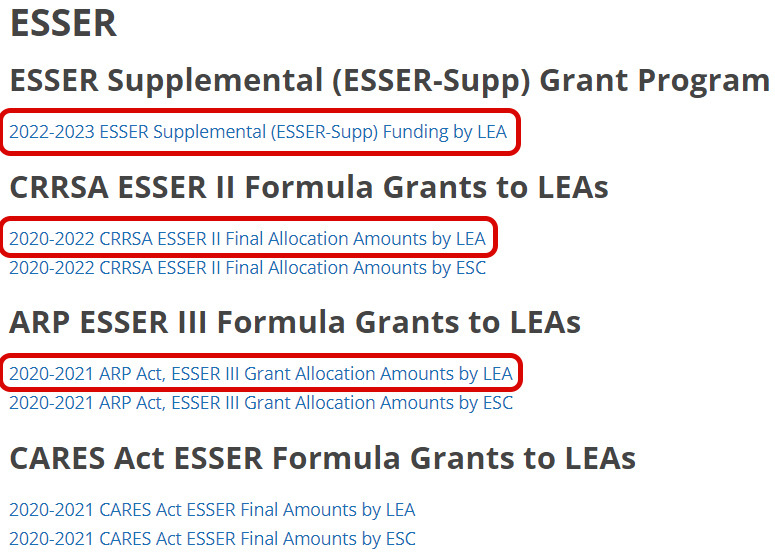We've had an overwhelming response to our survey on challenges teachers are facing this school year. The chart below offers a quick look at the overall results (click on it to see the full results). Below, you'll find a deeper look into the big issues and questions members raised to offer guidance and resources. We appreciate the feedback, and we will be sharing it with lawmakers, Commissioner Morath and other policymakers to let them know what our members are saying as we continue our advocacy efforts.

Reduce class sizes, hire more staff
Reducing class sizes and hiring additional staff topped the list for ways to improve a very challenging school year for both teachers and students, according to an analysis of survey responses.
With about 2,300 members responding, more than 1,800 teachers offered suggestions about what changes could make the school year better. The varied responses touched on COVID-specific sick leave and safety, ongoing concerns about compensation and extra duties, time-consuming professional development requirements and more.
The respondents cited teacher vacancies, COVID-related absences and a lack of substitutes as key factors leading to ballooning class sizes. Packing too many students in a classroom undermines COVID safety measures, of course. But it also contributes to behavior issues and makes it difficult for teachers to provide one-on-one attention to both student learning and emotional needs, the teachers reported.
At the same time, teachers are feeling the pressure to get students back on track academically after the past year and crowded classrooms could get in the way of those efforts. More paraprofessionals and support staff, however, could help them better manage the additional students.
State law sets a class-size limit of 22 students per teacher in prekindergarten through fourth grade, unless the district has sought a waiver from the commissioner of education or the school board has waived the limit under the Districts of Innovation statute. About 400 school districts have exempted themselves from the class-size limit.
For those teachers who’ve had to give up a planning period to cover a class, remember that state law entitles a teacher to at least 450 minutes of instructional preparation within each two-week period. Most districts have not waived this statutory provision.
Concerns about reading academies
Forty-five percent of respondents said their districts were requiring them to work more hours; almost half of those attributed the extra hours to reading academies. Seventy percent of respondents said they were not being paid for additional required time.
House Bill 3, passed in 2019 required all K-3 teachers and principals — with very few exceptions — to attend a teacher literacy achievement academy. The original legislation included a deadline of the 2021-22 school year, but that deadline was extended during the 2021 regular legislative session to the end of the 2022-23 school year.
Although the deadline extension may have eased the pressure a bit, many districts are requiring attendance now. K-3 teachers said they are becoming overwhelmed with the extra work required under the academies, especially when layered on top of staff shortages and other extra duties stemming from the need to mitigate COVID learning losses and help young students navigate the basics of classroom behavior.
The academy training, often requiring many hours outside of the regular school day and without additional pay for some teachers, is additionally frustrating for those who do not find the content to be relevant or useful. Many veteran teachers believe experienced reading teachers should be exempted.
Districts have some flexibility to ease the burden on teachers. As noted, the deadline for attending an academy was extended to the end of the 2022-23 school year. TEA has strongly encouraged districts to structure the academies within designated campuswide professional development and/or professional learning community days to ensure that staff has ample opportunity to complete the required content and to keep costs down.
Funding for stipends to compensate teachers for additional time may be available through several sources authorized in HB 3, and TEA has assured districts that federal COVID-relief/ESSER funds can be used to pay reading academy stipends.
Compensation for extra duties
Among the respondents to our recent survey who indicated that they were being required by their district to work extra hours, 69% said they were not getting paid for the extra time.
When asked what changes would make this year better, many survey respondents mentioned compensation in some form — either a pay raise or at least additional pay for additional work.
While money alone is clearly not an answer to the problems students and teachers are facing this year, higher salaries would undoubtedly help address the growing teacher shortage, ensuring that those who love teaching could afford to remain in the classroom, and attracting bright new educators into the profession.
Districts that are not paying their teachers for extra responsibilities and time may be able to do so legally (depending on the specific situation), as Texas law does not specify the length of a teacher’s work day. But this piling on of new duties and extra time without tangibly recognizing the strain being placed on their employees is pushing many teachers to the breaking point.
Most districts are getting a significant bump in funding this year from federal COVID-19 relief funds. They have discretion in how those funds are to be used, but compensation is clearly envisioned by both federal and state leaders as an appropriate use. FAQ documents from the federal government include the following as examples of how funds could be used: extra-duty pay for duties outside the normal workday and extended instructional time, stipends for additional responsibilities, performance stipends, retention bonuses, and training/professional development stipends.
Not all districts have received their full entitlement yet, and districts may choose to “bank” the funds for future use or to spend them on other priorities such as capital improvements (e.g., improved ventilation systems).
Sixty percent of our survey respondents said they were not aware of how their district is spending its federal funds. We encourage our members to look up what their districts should be receiving, using the information below, and have discussions with school officials and school board members about how those funds are to be used to benefit students and teachers.
HOW TO LOOK UP YOUR DISTRICT’S FEDERAL FUND ENTITLEMENT
Click here for the TEA page with links to the entitlement figures for Texas school districts and charter schools. You should click on the links outlined in red below for “LEAs” (local education agencies) for CRRSA (ESSER II) grants and for ARP (ESSER III) grants to see the amounts allocated by those two COVID relief bills. Districts with small Title I populations may receive supplemental funding under the ESSER Supplemental Grants. The CARES Act funding was essentially supplanted by the states, so those funds did not benefit your district.

Concerns about student discipline
For many students who hadn’t been in a classroom for 15 months, the return to in-person instruction this fall has been a difficult adjustment and teachers report some significant behavior challenges as a result, according to TCTA's recent member survey.
The lack of structure during virtual instruction is leading some students to think they can do whatever they want now that they’re back in the classroom. And the TikTok challenges to destroy school property and “slap a teacher” certainly aren’t helping matters.
Survey respondents noted that the disruptive behavior from a few was undermining their efforts to address the learning needs of other students. But the biggest frustration, they say, is a lack of backup from administrators, who have left teachers to handle behavior issues on their own.
TCTA Staff Attorney Julie Leahy advises teachers that they have the right to remove a student for disruptive conduct and, depending on the age of the student and the circumstances, more serious misconduct may require removal to the DAEP.
In addition, a TCTA-initiated law requires each campus to have a designated campus behavior coordinator who is primarily responsible for maintaining student discipline. Teachers should expect that administrators will enforce the student code of conduct, which is required by law.
As always, if a situation arises where you feel concerned about your options and/or legal rights and responsibilities regarding student discipline and classroom safety, call TCTA’s Legal Department at 888-879-8282.
Copyright© 2024 Texas Classroom Teachers Association® The Educated Choice® All rights reserved.
